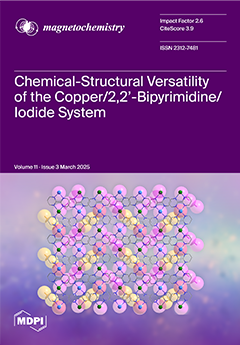The reaction in reagent grade acetone of copper(II) nitrate hexahydrate, 2,2′-bipyrimidine (bpm) and potassium iodide in a 1:2:2 molar ratio afforded three different products: an unreduced Cu(II) species, a fully reduced Cu(I) species and a mixed-valent Cu(II)/Cu(I) species. Of these, only the unreduced
[...] Read more.
The reaction in reagent grade acetone of copper(II) nitrate hexahydrate, 2,2′-bipyrimidine (bpm) and potassium iodide in a 1:2:2 molar ratio afforded three different products: an unreduced Cu(II) species, a fully reduced Cu(I) species and a mixed-valent Cu(II)/Cu(I) species. Of these, only the unreduced Cu(II) complex of formula [Cu
II(bpm)
3](I
3)(I) (
1) could be structurally characterized, the other two products being initially only isolated as amorphous powders. X-ray quality, beautifully shaped,
quasi-black prismatic crystals of compound
2, namely {[Cu
I(I
3)Cu
II(I)(bpm)
2](I
3)}
n, and brick-reddish parallelepipeds of compound
3, namely {[Cu
I2 (μ-I)
2(bpm)]}
n, were successively obtained through the slow diffusion in H-shaped tubes of aqueous solutions of the three reagents, after extensive optimization of the crystallization conditions. Compound
1 consists of a rare tris(2,2′-bipyrimidine)copper(II) monomeric dication, charge balanced by both iodide and triiodide anions. Compound
3, whose structure as well as optical and photocatalytic properties were recently disclosed, consists of a regular alternating
μ-bpm/di-
μ-iodide copper(I) chain. Finally, compound
2 consists of a rare, regular alternating mixed-valent Cu(II)-Cu(I)
μ-bpm copper chain, showing unusual similarities in the metal coordination environment. The magnetic properties of compound
2 remarkably reveal a very weak antiferromagnetic coupling between the paramagnetic Cu(II) ions which are well separated both intra- and inter-chain.
Full article





